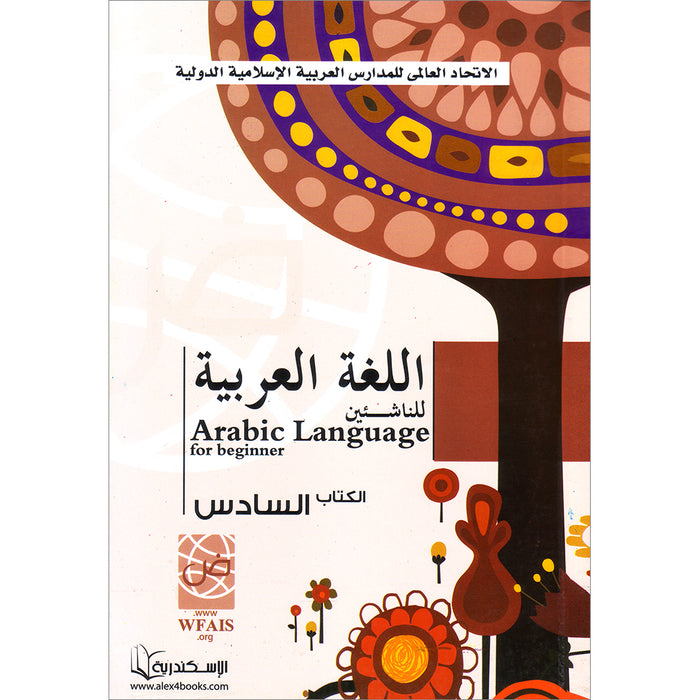Objectives of the Book:
- To teach students the importance of fulfilling their responsibilities.
- To teach students the dua before sleeping.
- To teach students the manners of Friday prayers.
- To teach students the benefits of good deeds.
- To teach students to keep in touch with family.
- To teach students the benefits of Ramadan and Laylat al-Qadr (The Night of Revelation).
Grammatical Structures:
- Using exclamation (ta'ajjub).
- Distinguishing nouns, verbs, and prepositions.
- Identifying prepositional phrases.
- Using the dual and the plural.
Lessons:
- Adel is Performing His Duty
- Bedtime Story
- Bedtime Dua
- The Student’s Dua
- Friday
- Good Deeds
- My Uncle’s Address
- Allah’s Power
- Visiting My Uncle
- A Telephone Conversation
- Ramadan
- A Night of Goodness
This series seeks to teach children Arabic and enhance the linguistic skills of non-Arabic speakers. The objectives are:
- To make the Arabic language appealing to students and enable them to understand spoken Arabic.
- To assist students in reading Arabic correctly, speaking it properly, and understanding it.
- To enrich students' linguistic resources so that they can form correct Arabic sentences.
- To educate students about the Arabic language heritage and Islamic culture.
- To allow students to broaden their horizons and learn other subjects delivered in Arabic.
- To help students learn to recite the Holy Quran, understand its meanings, and perform Islamic rituals in Arabic.
This series is based on five fundamentals:
- Psychology
- Linguistics
- Cultural Understanding
- Education
- Sociology
Students will learn the following linguistic skills in this order:
- Listening
- Speaking
- Reading
- Writing
Listening and speaking skills will:
- Accustom students to Arabic sounds.
- Give students an awareness of the changing meanings that can occur by changing the tone.
- Allow students to mimic the teacher in speech.
- Allow students to understand speech.
- Give students the opportunity to listen to Arabic conversations.
- Give students the opportunity to take part in regular conversation.
Reading skills are taught according to the Synthesis Method, which is as follows:
- The Total Method
- The Partial Method
- The Combination Method
- The Analysis Method
- The Vocal Method
Writing skills are based on direct dictation. The different dictation methods include:
- Imparted Dictation
- Visual Dictation
- Audible Dictation
- Experimental Dictation
Completion Time:
The books in this series are intended for use in schools. The time needed for each lesson is measured by the time of a standard class, which is 45 minutes. We call each class an instructional hour, meaning that the days specified to study the book may increase or decrease according to the hours specified in a day of studying.
Teaching Language:
Teachers should speak, explain, analyze, and discuss in formal fluent Arabic. They should not use an intermediary language at all.
الكتاب السادس
أهداف الكتاب
- تعميق قيمة أداء الواجب فى نفوس الدارسين.
- معرفة دعاء قبل النوم.
- معرفة آداب يوم الجمعة.
- معرفة فائدة العمل الصالح.
- تعويد الدارسين أن يصلوا أرحامهم.
- معرفة فضل شهر رمضان وليلة القدر.
التراكيب اللغوية
- استخدام صيغة التعجب.
- التمييز بين الاسم والفعل والحرف.
- معرفة الجار والمجرور.
- استخدام المثنى والجمع.
الثروة اللغوية
- درس (عادل يعمل الواجب).
- درس (قصة قبل النوم).
- درس (دعاء قبل النوم).
- درس (دعاء التلميذ).
- درس (يوم الجمعة).
- درس (العمل الصالح).
- درس (عنوان عمى).
- درس (قدرة الله).
- درس (زيارة عمى).
- درس (حديث فى التليفون).
- درس (رمضان).
- درس (ليلة الخير).
هذه السلسلة تسعى إلى تعليم المهارات اللغوية وتنميتها عند الأطفال الناطقين بغير العربية.
ومن أبرز أهداف هذه السلسلة ما يلى:
- تحبيب اللغة العربية فى نفوس الدارسين، وتمكينهم عند الاستماع إليها من فهم معانيها.
- تمكين الدارسين من قراءة اللغة العربية قراءة جهرية صحيحة مع فهم معنى المقروء.
- إمداد الدارسين بثروة لغوية كبيرة، لتيسر لهم تكوين الجمل العربية الصحيحة.
- التعرف على ملامح الثقافة الإسلامية والعربية.
- تمكين الدارسين من تعلم المواد الدراية الأخرى باللغة العربية.
- وهذا كله من شأنه أن يعين الدارسين على تلاوة القرآن الكريم وفهم معانيه وأداء الشعائر الدينية باللغة العربية.
وتقوم هذه السلسلة على خمسة أسس رئيسية هى:
- الأسس النفسية.
- الأسس اللغوية.
- الأسس الثقافية.
- الأسس التربوية.
- الأسس الاجتماعية.
ومن هنا سوف يتم تعليم الدارسين المهارات اللغوية حسب الترتيب التالى:
- مهارة الاستماع.
- مهارة الحديث.
- مهارة القراءة.
- مهارة الكتابة.
ونود الإشارة هنا إلى طرق التدريس التى نوصى باتباعها فى تدريس المهارات اللغوية المختلفة:
- مهارتا الاستماع والحديث: تدريس مهارتى الاستماع والحديث يهدف إلى:
- إلف الدارسين للأصوات العربية.
- أن يدرك الدارسون تغير المعنى بتغير النبر أو التنغيم فى الجملة الواحدة.
- تمكين الدارسين من محاكاة المدرس فى النطق.
- تمكين الدارسين من فهم المسموع إليه.
- القدرة على متابعة الاستماع إلى الأحاديث العربية.
- القدرة على التحدث باللغة العربية حديثًا عاديًّا مماثلا لحديث أبنائها.
- مهارة القراءة: طريقة تدريس مهارة القراءة سوف تسير حسب ما يسميه علماء التربية بالطريقة (التوليفية) التى تقوم على الاستفادة من الطرق الآتية:
- الطريقة الكلية.
- الطريقة الجزئية.
- الطريقة التركيبية.
- الطريقة التحليلية.
- الطريقة الصوتية.
- مهارة الكتابة: تقوم الطريقة التى تسير عليها مهارة الكتابة فى كتب هذه السلسلة على طريقة الإملاء المباشر الذى يستفيد من طرق الإملاء المختلفة وهى:
- الإملاء المنقول.
- الإملاء المنظور.
- الإملاء المسموع.
- الإملاء الاختبارى.
الخطة الزمنية:
كتب هذه السلسلة عبارة عن كتب مدرسية، لذلك فإن الوقت المرسوم لها يقاس بالحصة الدراسية التى مقدارها 45 خمس وأربعون دقيقة، ونطلق على كل حصة ساعة دراسية.
ومعنى هذا أن الأيام المخصصة لدراسة هذا الكتاب تزيد أو تنقص حسب الساعات التى تخصص يوميا لدراسته.
اللغة المستخدمة فى التدريس:
المدرس القائم بعملية التدريس مطلب بالتحدث أو الشرح أو التحليل أو المناقشة باللغة العربية الفصيحة، ولا يجوز له استعمال لغة وسيطة مهما كانت هذه اللغة.


























